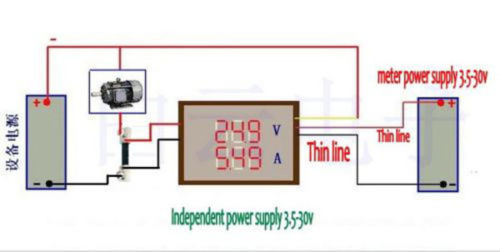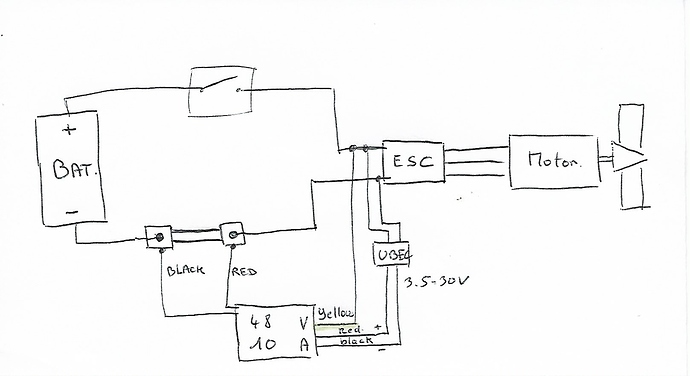I’m afraid could be a problem of how they attach the mosfet to the cooling plate… There’s a video on YouTube showing this…lots of thermal paste, too much distance to get an effective cooling… I cannot find the video now but checking means opening the heat shrink and partially disassemble the esc…
I think you should contact supplier, seem like that esc has an issue. Should run warm not hot. We are using the 400A waterproof flier and it ls awesome!
Is there a fair distance between your batteries and the ESC? If there is you will need to add an extra cap bank to deal with the ripple current. Something like this Etti ESC Capacitor Bank High Voltage | Offshore Electrics would most likely just benefit you regardless of the wire length.
Yes I’m using a cap bank. The cables of the battery to the ESC are not more than 15cm.
@Vefoil: Did you measure your max. Temp. of the ESC?
Its always been body temperature to the touch after use. We have a lot of cold water running through ours as you can see here on post I shared Cooling the ESC - #108 by VeFoil - Electronics (ESC, remote, batteries) - FOIL.zone
Hello
I want to connect a voltemetre / amperemetre on my engine but I do not know how to connect it with ESC, someone would til a schema connection or advice, in advance thank you?
You can measure the battery voltage and the current between the battery and the esc (either with a shunt or a hall sensor in the path of the load).
Power taken by the motor is Ubat*Ibatt - losses (esc and cables). With those values you can also calculate the remaining battery charging level.
A display which needs such independent power supply is not state of the art. The additional power supply will always fail in the worst moment. If you just want a good display for your ride, including Ah counting, the TF02 coulomb meter is the right choice. You can order it with different shunts and voltages and i think its price worthy. It cannot log the data or share it with other devices, so its a stand alone. It does not loose Ah counting when being completely shut off which is great. The display is large and bright enough to read it while standing on the board. The shunts delivered are great and my TF02 did not need any additional calibration, just worked out of the box. It has a high resolution current measurement, already a few W are correctly displayed. It implements a fuel gauge in %. So, i cannot recommend an ESC, but at least an Ah counter.
I’m successfully using this one and can really recommend it. You even don’t need to solder the big cables, it’s really compact and it is as well bright enough for being seen at foiling.
DC 300V 100A 200A 400A digital Voltmeter Ammeter Battery Capacity coulometer Power electricity watt-hour meter With Hall sensor
http://s.aliexpress.com/ZRnAZNZv
Be careful to have the buttons on the backside, as you cannot waterproof them on the frontside and it is also needless to reach them while in water.
I couldn’t find this display with the buttons on the back. I printed an extra frame which I can dissemble quite quickly. But you are totally right.
Will 12s 160A (or even cca 120 esc) watercooled be sufficient if i limit current to 60-70? (motor and gearhead are rated little over 3kW max, will run 10-12s). I dont seem to get do esc’s fail cause of user error (melts, shorts, leaks somewhere in instalation) or just by themselves. is it a good idea?
Hello
thank you for your answer, can you make me a sketch or give me a diagram for the connection, thank you
here is my connection diagram, I get the voltage but not the amperes, can someone tell me if my connection is good?
I think A measurments needs to be done in serie with the main power. While voltage can be done between the terminals(paralell). Looks like you do both measurements in parallel?
Hall sensor on positive
others on negative
exemple of TF02 :http://kimgrity.com/test-equipment-and-tool-c-58/100v-350a-battery-coulometer-tf02-coulomb-counter-universal-battery-capacity-tester-for-recreational-vehicle-p-553.html#.Wxw2L8TLjIU
why do you use a ubec? is it 10A sensor? have select the correct range for the shunt?
I found, it works, I had a common mass, so I removed my ubec and I feed my amperemetre by another small battery 1S, and it works, thank you for your answers
I have an intensity at full engine speed of 6 Ampere vacuum, is it well, how much do you have?
I contacted the Flier engineers for more details of the cooling of my 320A 16S Boat ESC:
-max. temperature should not exceed 110° celsius
-it don’t has an over temperature cut off
-they could not tell me the recommended water flow rate
Just to let you know
